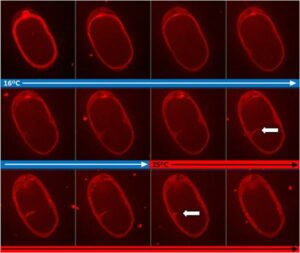Introduction
Research has already shown a proper establishment of cell polarity is vital for several events during development stages and morphogenesis. This paper from Sukriti Kapoor & Sachin Kotak aimed at understanding the mechanisms involved in the cortical anisotropy allowing the actomyosin network to promote cell polarit. This study in C. elegans embryo shows the role of Aurora A kinase (AIR-1) as regulator of PAR-2, to create a singularity in the polarity establishment axis. ECT-2 (Rho GEF), downstream, is also involved in the regulation of contractility and localization of PAR-2. AIR-1 acts as the polarizing signal at the centrosome, initiating the polarity establishment due to its impact on actomyosin-based cortical contractility.

Ultra fast temperature shift device for in vitro experiments under microscopy
Abstract
Proper establishment of cell polarity is essential for development. In the one-cell C. elegans embryo, a centrosome-localised signal provides spatial information for polarity establishment. It is hypothesised that this signal causes local inhibition of the cortical actomyosin network, and breaks symmetry to direct partitioning of the PAR proteins. However, the molecular nature of the centrosomal signal that triggers cortical anisotropy in the actomyosin network to promote polarity establishment remains elusive. Here, we discover that depletion of Aurora A kinase (AIR-1 in C. elegans) causes pronounced cortical contractions on the embryo surface, and this creates more than one PAR-2 polarity axis. This function of AIR-1 appears to be independent of its role in microtubule nucleation. Importantly, upon AIR-1 depletion, centrosome positioning becomes dispensable in dictating the PAR-2 axis. Moreover, we uncovered that a Rho GEF, ECT-2, acts downstream of AIR-1 in regulating contractility and PAR-2 localisation, and, notably, AIR-1 depletion influences ECT-2 cortical localisation. Overall, this study provides a novel insight into how an evolutionarily conserved centrosome Aurora A kinase inhibits promiscuous PAR-2 domain formation to ensure singularity in the polarity establishment axis.
References
FAQ
The correct establishment of cell polarity is considered essential for development. It is an important process for several events that occur during morphogenesis and different developmental stages. The one-cell Caenorhabditis elegans embryo is often used as a model for these investigations. In this embryo, a signal that is localised to the centrosome provides the spatial information needed for polarity to be established. Studies in this model are aimed at understanding the mechanisms involved in cortical anisotropy. This anisotropy is what permits the actomyosin network to promote the establishment of cell polarity.
Aurora A kinase, known as AIR-1 in C. elegans, functions as a regulator of PAR-2. It is identified as the polarizing signal that is localised at the centrosome. Its function is to maintain a single axis of polarity. This is achieved by AIR-1 inhibiting the formation of unwanted PAR-2 domains. The kinase initiates the establishment of polarity. This is done through its effect on the contractility of the actomyosin-based cortex. When AIR-1 is depleted from the embryo, pronounced cortical contractions are seen on the surface. This loss of AIR-1 also results in the creation of more than one PAR-2 polarity axis. This specific function seems to be separate from the protein’s other role in microtubule nucleation.
When Aurora A kinase (AIR-1) is depleted, notable effects are observed in the C. elegans embryo. Pronounced cortical contractions appear on the surface of the embryo. The depletion also causes the formation of more than one PAR-2 polarity axis. This finding indicates that AIR-1 normally functions to inhibit the creation of these extra PAR-2 domains. This maintains that only a single axis of polarity is established. A significant consequence of AIR-1 depletion is that the position of the centrosome becomes unnecessary for dictating the PAR-2 axis. This suggests the centrosome’s spatial information is mediated through AIR-1. The depletion of AIR-1 also affects the localisation of the ECT-2 protein at the cortex.
A protein called ECT-2, which is a Rho GEF, is involved in regulating cell polarity. It was found that ECT-2 functions downstream of the Aurora A kinase (AIR-1). This places it later in the signalling pathway that establishes the polarity axis. The role of ECT-2 is related to two processes. It is involved in the regulation of contractility. It also participates in the localisation of the PAR-2 protein. A connection between AIR-1 and ECT-2 was identified. It was observed that the depletion of AIR-1 has an influence on the cortical localisation of ECT-2.




